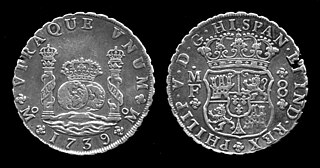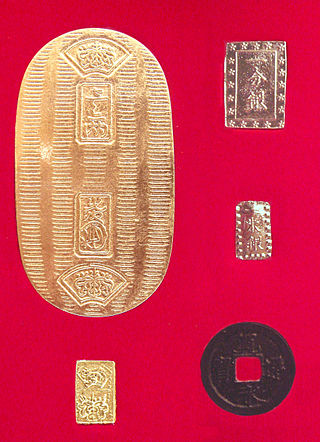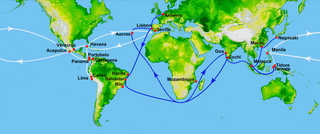Related Research Articles
A currency is a standardization of money in any form, in use or circulation as a medium of exchange, for example banknotes and coins. A more general definition is that a currency is a system of money in common use within a specific environment over time, especially for people in a nation state. Under this definition, the British Pound sterling (£), euros (€), Japanese yen (¥), and U.S. dollars (US$) are examples of (government-issued) fiat currencies. Currencies may act as stores of value and be traded between nations in foreign exchange markets, which determine the relative values of the different currencies. Currencies in this sense are either chosen by users or decreed by governments, and each type has limited boundaries of acceptance; i.e., legal tender laws may require a particular unit of account for payments to government agencies.

A gold standard is a monetary system in which the standard economic unit of account is based on a fixed quantity of gold. The gold standard was the basis for the international monetary system from the 1870s to the early 1920s, and from the late 1920s to 1932 as well as from 1944 until 1971 when the United States unilaterally terminated convertibility of the US dollar to gold, effectively ending the Bretton Woods system. Many states nonetheless hold substantial gold reserves.

In economics, inflation is a general increase in the prices of goods and services in an economy. This is usually measured using the consumer price index (CPI). When the general price level rises, each unit of currency buys fewer goods and services; consequently, inflation corresponds to a reduction in the purchasing power of money. The opposite of CPI inflation is deflation, a decrease in the general price level of goods and services. The common measure of inflation is the inflation rate, the annualized percentage change in a general price index. As prices faced by households do not all increase at the same rate, the consumer price index (CPI) is often used for this purpose.
In economics, deflation is a decrease in the general price level of goods and services. Deflation occurs when the inflation rate falls below 0%. Inflation reduces the value of currency over time, but deflation increases it. This allows more goods and services to be bought than before with the same amount of currency. Deflation is distinct from disinflation, a slowdown in the inflation rate; i.e., when inflation declines to a lower rate but is still positive.
The Specie Payment Resumption Act of January 14, 1875 was a law in the United States that restored the nation to the gold standard through the redemption of previously unbacked United States Notes and reversed inflationary government policies promoted directly after the American Civil War. The decision further contracted the nation's money supply and was seen by critics as an exacerbating factor of the so-called Long Depression, which struck in 1873.

The Bland–Allison Act, also referred to as the Grand Bland Plan of 1878, was an act of the United States Congress requiring the U.S. Treasury to buy a certain amount of silver and put it into circulation as silver dollars. Though the bill was vetoed by President Rutherford B. Hayes, the Congress overrode Hayes's veto on February 28, 1878, to enact the law. The text of the act can be found in the Congressional Record under the further reading section of this article.
In European history, the commercial revolution saw the development of a European economy – based on trade – which began in the 11th century AD and operated until the advent of the Industrial Revolution in the mid-18th century. Beginning c. 1100 with the Crusades, Europeans rediscovered spices, silks, and other commodities then rare in Europe. Consumer demand fostered more trade, and trade expanded in the second half of the Middle Ages. Newly forming European states, through voyages of discovery, investigated alternative trade routes in the 15th and 16th centuries, which allowed European powers to build vast, new international trade networks. Nations also sought new sources of wealth and practiced mercantilism and colonialism. The Commercial Revolution is marked by an increase in general commerce, and in the growth of financial services such as banking, insurance, and investing.
The economy of governments covers the systems for setting levels of taxation, government budgets, the money supply and interest rates as well as the labour market, national ownership, and many other areas of government interventions into the economy.

Monetary policy is the policy adopted by the monetary authority of a nation to affect monetary and other financial conditions to accomplish broader objectives like high employment and price stability. Further purposes of a monetary policy may be to contribute to economic stability or to maintain predictable exchange rates with other currencies. Today most central banks in developed countries conduct their monetary policy within an inflation targeting framework, whereas the monetary policies of most developing countries' central banks target some kind of a fixed exchange rate system. A third monetary policy strategy, targeting the money supply, was widely followed during the 1980s, but has diminished in popularity since that, though it is still the official strategy in a number of emerging economies.

Bimetallism, also known as the bimetallic standard, is a monetary standard in which the value of the monetary unit is defined as equivalent to certain quantities of two metals, typically gold and silver, creating a fixed rate of exchange between them.

The patio process is a process for extracting silver from ore. Smelting, or refining, is most often necessary because silver is only infrequently found as a native element like some metals nobler than the redox couple 2 H+ + 2 e−⇌ H
2 (gold, mercury, ...). Instead, it is made up of a larger ore body. Thus, smelting, or refining, is necessary to reduce the compound containing the Ag+ cation into metallic Ag and to remove other byproducts to get at pure silver. The process, which uses mercury amalgamation to recover silver from ore, was first used at scale by Bartolomé de Medina in Pachuca, Mexico, in 1554. It replaced smelting as the primary method of extracting silver from ore at Spanish colonies in the Americas. Although some knowledge of amalgamation techniques were likely known since the classical era, it was in the New World that it was first used on a large industrial scale. Other amalgamation processes were later developed, importantly the pan amalgamation process, and its variant, the Washoe process. The silver separation process generally differed from gold parting and gold extraction, although amalgamation with mercury is also sometimes used to extract gold. While gold was often found in the Americas as a native metal or alloy, silver was often found as a compound such as silver chloride and silver sulfide, and therefore required mercury amalgamation for refinement.
The history of the United States dollar began with moves by the Founding Fathers of the United States of America to establish a national currency based on the Spanish silver dollar, which had been in use in the North American colonies of the Kingdom of Great Britain for over 100 years prior to the United States Declaration of Independence. The new Congress's Coinage Act of 1792 established the United States dollar as the country's standard unit of money, creating the United States Mint tasked with producing and circulating coinage. Initially defined under a bimetallic standard in terms of a fixed quantity of silver or gold, it formally adopted the gold standard in 1900, and finally eliminated all links to gold in 1971.

The silver standard is a monetary system in which the standard economic unit of account is a fixed weight of silver. Silver was far more widespread than gold as the monetary standard worldwide, from the Sumerians c. 3000 BC until 1873. Following the discovery in the 16th century of large deposits of silver at the Cerro Rico in Potosí, Bolivia, an international silver standard came into existence in conjunction with the Spanish pieces of eight. These silver dollar coins played the role of an international trading currency for nearly four hundred years.

Money is any item or verifiable record that is generally accepted as payment for goods and services and repayment of debts, such as taxes, in a particular country or socio-economic context. The primary functions which distinguish money are: medium of exchange, a unit of account, a store of value and sometimes, a standard of deferred payment.

The United States dollar is the official currency of the United States and several other countries. The Coinage Act of 1792 introduced the U.S. dollar at par with the Spanish silver dollar, divided it into 100 cents, and authorized the minting of coins denominated in dollars and cents. U.S. banknotes are issued in the form of Federal Reserve Notes, popularly called greenbacks due to their predominantly green color.

Fiat money is a type of currency that is not backed by a precious metal, such as gold or silver. It is typically designated by the issuing government to be legal tender, and is authorized by government regulation. Since the end of the Bretton Woods system in 1971, the major currencies in the world are fiat money.

Tokugawa coinage was a unitary and independent metallic monetary system established by shōgun Tokugawa Ieyasu in 1601 in Japan, and which lasted throughout the Tokugawa period until its end in 1867.
Monetary policy in the United States is associated with interest rates and availability of credit.

The global silver trade between the Americas, Europe, and China from the sixteenth to nineteenth centuries was a spillover of the Columbian exchange which had a profound effect on the world economy. Many scholars consider the silver trade to mark the beginning of a genuinely global economy, with one historian noting that silver "went round the world and made the world go round". Although global, much of that silver ended up in the hands of the Chinese, as they accepted it as a form of currency. In addition to the global economic changes the silver trade engendered, it also put into motion a wide array of political transformations in the early modern era. "New World mines", concluded several prominent historians, "supported the Spanish empire", acting as a linchpin of the Spanish economy.

Della Moneta is a 1751 book written by Ferdinando Galiani, and is considered one of the first specific treatises on economics, especially monetary theory, preceding Adam Smith's The Wealth of Nations by twenty-five years.
References
- ↑ Levack, Muir, Veldman, Maas, Brian (2007). The West: Encounters and Transformations, Atlas Edition, Volume 2 (since 1550) (2nd ed.). England: Longman. p. 96. ISBN 9780205556984.
{{cite book}}: CS1 maint: multiple names: authors list (link) - ↑ Fischer, David Hackett (1996). The Great Wave: Price Revolutions and the Rhythm of History . New York: Oxford University Press. ISBN 978-0-19-505377-7.
- 1 2 3 4 5 Munro, John (2008). "Money, Prices, Wages, and 'Profit Inflation' in Spain, the Southern Netherlands, and England during the Price Revolution era: ca. 1520 - ca. 1650". História e Economia Revista Interdisciplina. University of Toronto: 12–71.
- 1 2 3 Evan, Tomáš (2014). European Economic History: The World before the Rise of the Global Economy.
- 1 2 Kugler, Peter; Bernholz, Peter (2007). The price revolution in the 16th century: empirical results from a structural vectorautoregression model. Basel: WWZ.
- 1 2 3 4 Fisher, Douglas (December 1989). "The Price Revolution: A Monetary Interpretation". The Journal of Economic History. 49 (4): 883–902. doi:10.1017/S0022050700009487. JSTOR 2122742. S2CID 154918816.
- 1 2 3 North, Michael. The Money and Its History from the Middle Ages to the Present. Munich: Beck, 1994.
- 1 2 3 4 5 6 Hamilton, Earl J. (1934). American treasure and the price revolution in Spain, 1501–1650. New York: Octagon Books.
- ↑ Kindleberger, Charles Poor. Economic and Financial Crises and Transformations in Sixteenth-century Europe. Princeton, N.J.: International Finance Section, Department of Economics, Princeton University, 1998.
- ↑ Nef, J. U. (1941). Silver Production in Central Europe, 1450-1618. Journal of Political Economy, 49(4), 575–591.
- ↑ D. Flynn, "Comparing the Tokugawa Shogunate with Hapsburg Spain: two silver-based empires in a global setting", in James Tracy (ed), The Political Economy of Merchant Empires, 1350-1750 (1991), p.352
- 1 2 3 Hamilton, Earl J. (1965). American Treasure and the Price Revolution in Spain, 1501-1650. New York: Octagon.
- ↑ Greaves, Percy L.; Mises, Ludwig (1974). Mises Made Easier: A Glossary for Ludwig Von Mises' Human Action. Dobbs Ferry, N.Y.: Free Market.
- ↑ Hutchinson, Marjorie (1952). The School of Salamanca; Readings in Spanish Monetary Theory, 1544-1605. Oxford: Clarendon.
- ↑ http://www.usu.edu/markdamen/1320Hist&Civ/PP/slides/06blackdeath.pdf Archived 2014-06-11 at the Wayback Machine [ bare URL PDF ]
- ↑ "West Chester University". Archived from the original on 2019-05-16.
- ↑ Ziegler, Philip (2003). The Black Death. Harper Collins. ISBN 978-0862998387.
- ↑ Clough, Shepard B., and Richard T. Rapp. European Economic History: The Economic Development of Western Civilization. 3d ed. New York: McGraw-Hill, 1975.
- ↑ Clough, Shepard B. (1968). European Economic History; the Economic Development of Western Civilization (3rd ed.). New York: McGraw-Hill.
- 1 2 Wernham, R. B. (1968). The Counter-Reformation and Price Revolution, 1559–1610. Cambridge: Cambridge University Press.
- ↑ Themes in International Economics by Mats Lundahl
- ↑ Spanish Opposition to Charles V's Foreign Policy
- ↑ Gold and Silver: Spain and the New World Archived 2008-10-07 at the Wayback Machine University of California
- 1 2 3 4 Lynch, John. "Spain During the Price Revolution" (PDF). Archived from the original (PDF) on 2017-02-08. Retrieved 2017-08-17.
- 1 2 Fratianni, Michele; Franco, Spinelli (2006). Did Genoa and Venice Kick a Financial Revolution in the Quattrocento?. Vienna: Oesterreichische Nationalbank.
- ↑ J Conklin (1998) The Theory of Sovereign Debt and Spain under Philip II
- ↑ Debt policy under constraints: Philip II, the Cortes, and Genoese bankers by CARLOS ÁLVAREZ-NOGAL and CHRISTOPHE CHAMLEY, p. 2